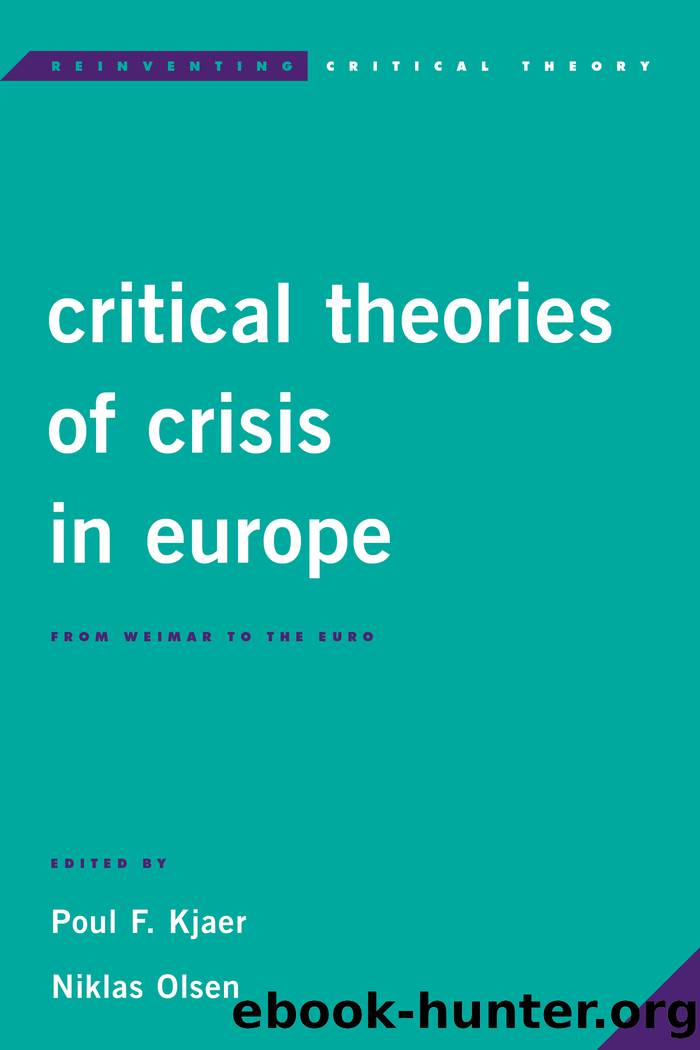Critical Theories of Crisis in Europe by Kjaer Poul F.;Olsen Niklas;Olsen Niklas;

Author:Kjaer, Poul F.;Olsen, Niklas;Olsen, Niklas;
Language: eng
Format: epub
Tags: undefined
Publisher: Rowman & Littlefield Unlimited Model
Published: 2012-08-15T00:00:00+00:00
Conclusion
In the aftermath of the financial crisis of 2008, failing labour markets were identified as a primary cause of stagnating economies and, accordingly, as a primary target for reform. As national governments and supranational institutions moved to prescribe programmes of reform, flexibility figured as the key to well-functioning markets. In this respect, there was a significant degree of continuity with âThird Wayâ and âflexicurityâ policy prescriptions. Now, however, there was far less emphasis by government on the capacity of innovations to benefit all, and a much greater tendency, instead, to assert and emphasize the existence of conflicts of interest between different groups of workers: labour market insiders and outsiders, strivers and shirkers, striking railway workers and hardworking commuters. Such conflicts of interest were then used to justify reforms aimed at lowering labour standards, cutting welfare payments, or restricting workersâ freedom of association.
In policy debates and academic discussions alike, the identification of conflicts of interest between different workers or groups of workers has been based quite routinely upon a depiction of labour markets as dually segmented; upon the characterization of some workers as labour market insiders, and others as labour market outsiders. This is oversimplistic, tending to overlook and obscure the extent to which workers also share an interest in the improvement of wages and other terms and conditions, and the ways in which workersâ interests can conflict with those of employing organizations. It was suggested in this chapter that the analysis of labour markets and labour law ought to take account also of the interests of employing organizations and the strategies employed by them to further those interests. In seeking to identify the interests of various market actors, moreover, scholars and policymakers ought to seek to understand markets and market behaviour not in the abstract, but with reference, instead, to the specific configuration of particular economies and economic institutions. These, perhaps, are the enduring lesson of old approaches to the study of labour law, exemplified par excellence in the work of Hugo Sinzheimer.
Download
This site does not store any files on its server. We only index and link to content provided by other sites. Please contact the content providers to delete copyright contents if any and email us, we'll remove relevant links or contents immediately.
The remains of the day by Kazuo Ishiguro(7584)
Tools of Titans by Timothy Ferriss(6980)
The Black Swan by Nassim Nicholas Taleb(6215)
Inner Engineering: A Yogi's Guide to Joy by Sadhguru(5920)
Giovanni's Room by James Baldwin(5901)
The Way of Zen by Alan W. Watts(5814)
The Six Wives Of Henry VIII (WOMEN IN HISTORY) by Fraser Antonia(4803)
The Power of Now: A Guide to Spiritual Enlightenment by Eckhart Tolle(4780)
Astrophysics for People in a Hurry by Neil DeGrasse Tyson(4634)
Asking the Right Questions: A Guide to Critical Thinking by M. Neil Browne & Stuart M. Keeley(4609)
12 Rules for Life by Jordan B. Peterson(3760)
The Ethical Slut by Janet W. Hardy(3520)
Skin in the Game by Nassim Nicholas Taleb(3489)
Housekeeping by Marilynne Robinson(3427)
The Art of Happiness by The Dalai Lama(3396)
Double Down (Diary of a Wimpy Kid Book 11) by Jeff Kinney(3292)
Skin in the Game: Hidden Asymmetries in Daily Life by Nassim Nicholas Taleb(3280)
Walking by Henry David Thoreau(3242)
12 Rules for Life: An Antidote to Chaos by Jordan B. Peterson(3211)
